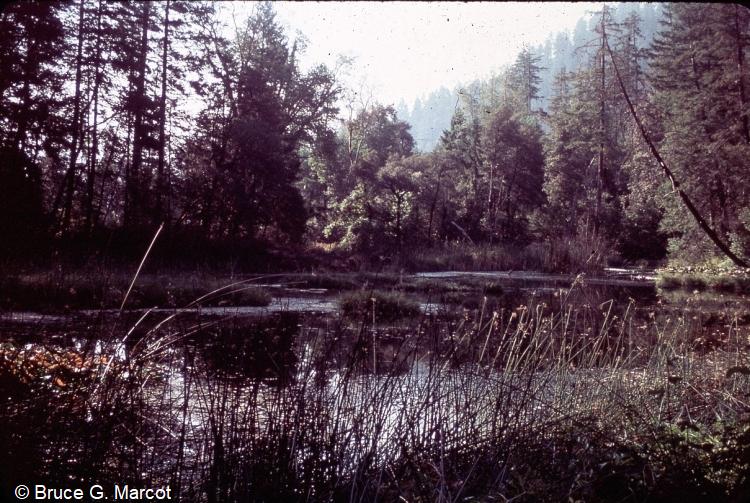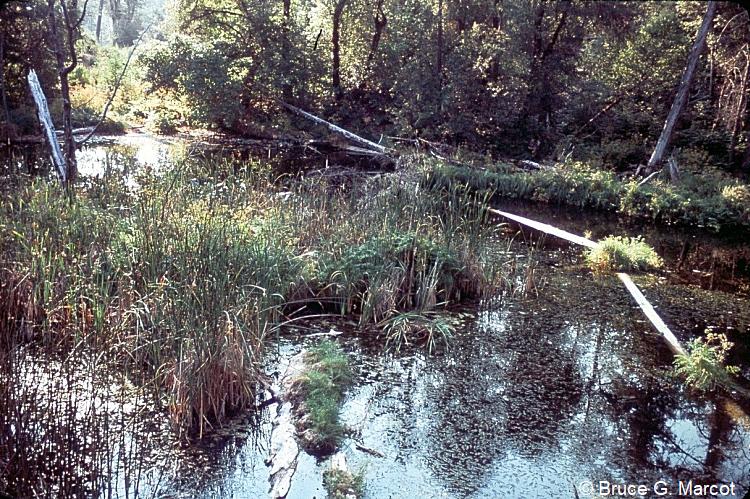|
Explanation: Ah,
the fetid and fertile pond of life! This is Primal Pond, so-named
by yours truly during my 1977 thesis project exploring the limnology and
wildlife use of slump-formed ponds in remote and unstudied corners of the
Klamath Mountains of northwestern California. The
name "primal" came to mind instantly, as I encountered this unknown
and then-unnamed site, as I observed the dense array of wildlife attracted to
its waters and to its riparian shores -- where I tracked a mountain lion
(cougar) and black bear; observed pond turtles, fence lizards, alligator
lizards, skinks, gopher snakes, and racer snakes; counted the abundance of
bird species including wood ducks, red-tailed hawks, kingfishers, woodpeckers,
flycatchers, and much more; and trapped and observed shrews, pocket gophers,
chipmunks, deer, deer mice, and others.

Scanned from one of my 1977 Ektachrome 35mm slides, this image
of Primal Pond shows bulrush in the foreground, one of the emergent
aquatic species along the shoreline forming a floating mat as
shown in my pond surface map.
On the right is a leaning tree, soon to become part of the
floating log flotilla that serves as wildlife perch, access, and foraging
sites.
In the top image above, I had created a surface map of the pond showing
emergent vegetation, and floating logs that came from naturally fallen
trees. The logs were particularly key resting, perch, and access sites
for pond turtles, raccoons, and other critters of the day and night.

Also from 1977, this image of Primal Pond better displays
some of the emergent vegetation clumps and the floating logs.
A primal visage, indeed ...
My rediscovery of Primal Pond occurred on Google Maps -- shown in the
second image in the main panels above. It, and the host of the other
ponds I included in that early study, were not easy to relocate. My
original study maps only showed locations in terms of township, range, and
section, and I had to covert those to latitude and longitude, but ... there
they were, and there was my Primal Pond.
Comparing
my surface map from 1977 to this Google Earth image from May 2014 showed two
main features: (1) some of the surface vegetation and logs persisted,
although the vegetation patches have become rearranged and spread, and some of
the previous floating logs likely sunk and new ones have entered; and (2) the
main point: the pond was still there, and had not been naturally or
artificially drained or dried. It was heartening to see how these ponds
can persist in this environment where summers are increasingly arid, and
wildfires increasingly toast the landscapes. I
hope to physically return to these pond study sites some day and repeat my
studies of vegetation and wildlife use, to see how they have
changed. But for now ... I am most pleased at this recent Primal Pond
Rediscovery.
Information:
Marcot, B. G. 1978. Flora and fauna of existing and potential slump pond
sites in Six Rivers National Forest with recommendations for management.
M.S. Thesis, Humboldt State University, Arcata CA.
Marcot, B. G. 1990. Limnology, vegetation, and
classification of Coast Range slump-formed ponds. Northwest Science
64(1):55-63.
Acknowledgment:
The
photograph most immediately above was taken by my field research helper
Douglas Osmundson, whose assistance in this 1977 study was, and is, greatly
appreciated.
|
Index |
Location | Search | About EPOW | ... Next >
Google Earth locations